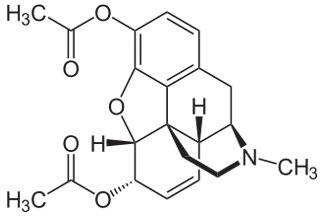Heroin
Heroin (or diacetylmorphine) is a semi-synthetic opioid derived from morphine. Intravenously-injected heroin causes a rush of powerful euphoria lasting a few minutes, followed by sedation lasting a few hours. Medically, heroin is no longer used in the treatment of pain except in the UK, where it is sometimes used in the treatment of severe pain caused by cancer or other terminal illnesses.
Heroin was first synthesized in 1874 by English chemist C.R. Wright. But its commercial value was first recognized in 1897 by Heinrich Dreser and Felix Hoffman at the Bayer pharmaceutical laboratory -- the same researchers who invented aspirin, which is is made by a similar process. Heroin was intended to be a less-addictive substitute for other common opiates.
In the late nineteenth and early twentieth centuries, heroin was common in over-the-counter medicines, but it was made illegal in the United States in 1924 through the Heroin Act. In the second half of the twentieth century, heroin was widely stigmatized as the quintessential illicit drug, as images of urban heroin addicts were propagated by media reports.
Heroin is primarily produced in Colombia, Mexico, Southeast Asia (especially Burma), and Afghanistan. Depending on how it is processed, it ranges from a thick sticky "black tar" to a brown, tan, or white powder. Street material varies greatly in potency from as high as 95% purity to as low as 5 or 10% purity. Heroin is most commonly injected (intravenously, intramuscularly, or subcutaneously), smoked, or insufflated (snorted).
Brand Names
None
Street Names
Heroin, dope, smack, junk, H, black tar, horse, chiva
Formulations
None in North America. In the UK and the few other countries who offer prescription heroin for long-time addicts, pharmaceutical grade heroin is usually used in the form of a intravenous (IV) solution.
On the street, heroin is available in a powdered form, and in the form of a black tar. Purity can range from <1% to >90%, and users often never know what other substances the heroin may be cut with.
Medical Uses
- In the UK, it is rarely used to treat severe pain such as in severe physical trauma, heart attack, and chronic pain stemming from end-stage cancer and other terminal illnesses
- In a few other countries, it is also used as a maintenance drug to treat addicts who have failed multiple other treatment methods such as methadone maintenance
Route of Administration
inhalation (smoking), insufflation (snorting), intravenous (IV), intramuscular (IM), oral, rectal
Half-life
2-3 h *note: Heroin metabolizes into morphine quickly with a half-life <10 minutes. Morphine's half-life is listed instead.
Medical Dosage
severe pain (from heart attack, cancer, other terminal illness): 10 to 15 mg IV
Legality
- In the United States, diacetylmorphine (heroin) is a Schedule I drug.
- In Canada, diacetylmorphine (heroin) is a controlled substance under Schedule I.
- Heroin is illegal to possess and sell in most other countries worldwide.
Images
References
- Schumacher MA, Basbaum AI, Way WL, Opioid Analgesics & Antagonists (Chapter 31) in: Basic and Clinical Pharmacology. 12e. Katzung BG, Masters SB, Trevor AJ (Editors). McGraw-Hill / Lange, 2012.
- Controlled Substances - Alphabetical Order. DEA Office of Diversion Control, May 2013. [PDF]
- Controlled Drugs and Substances Act. Minister of Justice, Canada, Nov 2012. [PDF]
- Classification of controlled drugs - National systems in the EU and Norway. European Monitoring Centers for Drugs and Drug Addiction (EMCDDA), Jan 2012.
- Heroin Legal Status. Vaults of Erowid. Erowid.org, Oct 2012.
Related Pages
-
Opium
Opium is the dried latex obtained from the seedpod of the opium poppy (Papaver somniferum). Morphine is the main narcotic constituent of opium. Read about the other alkaloids found in opium, how opium was used throughout history, and how opium is still used today. -
Methadone
Methadone is a synthetic opioid that is most commonly used as a maintenance treatment for opioid addiction. Methadone is also used in managing severe chronic pain, due to its long duration of action, high potency, and very low cost. -
Opioid Withdrawal
Opioid withdrawal refers to the symptoms that can occur after stopping or reducing intake of opioid drugs in opioid-dependent persons. Find out what the symptoms of withdrawal are and how long they last. -
Methadone Maintenance
Methadone Maintenance Treatment (MMT) has been proven to be a safe and effective treatment for opioid dependence and addiction. Read about the history of. methadone and how a methadone treatment program works.
